3- Exercises and Techniques to Improve Posture
Now that we’ve covered the fundamentals of posture and highlighted the most common mistakes to avoid, it’s time to focus on practical ways to improve it. Correcting posture isn’t just about sitting up straight but it involves training your body through exercises that build strength, increase flexibility, and support long-term alignment. A strong core, stable spine, and flexible muscles all contribute to a healthier posture, and incorporating targeted exercises into your daily routine can make a noticeable difference. In this section, we’ll explore effective strengthening exercises like planks, bridges, and shoulder blade squeezes, which focus on core stability and upper back support. We’ll also go over key stretches for the chest, shoulders, hamstrings, and hip flexors, which help relieve tightness and restore balance to the body. For those looking to go a step further, practices like yoga and Pilates offer full-body conditioning that improves both posture and body awareness. And finally, we’ll take a look at helpful posture-correction tools like ergonomic chairs and lumbar supports that can assist in maintaining proper alignment throughout the day. Each of these techniques plays a role in helping you stand taller, feel better, and move with more confidence.
Strengthening Exercises
Strength is a key component of good posture. When the muscles that support your spine and keep your body upright are weak, it’s easy to slip into slouching or misalignment without even noticing. That’s why incorporating specific strengthening exercises into your routine is one of the most effective ways to improve posture over time. These exercises don’t need to be intense or time-consuming. Simple, focused movements done consistently can help build the core and upper body strength necessary for proper alignment and better posture habits. Below, we’ll explore three powerful exercises that target essential postural muscles: planks and bridges for core stability, back extensions for spinal support, and shoulder blade squeezes for strengthening the upper back.
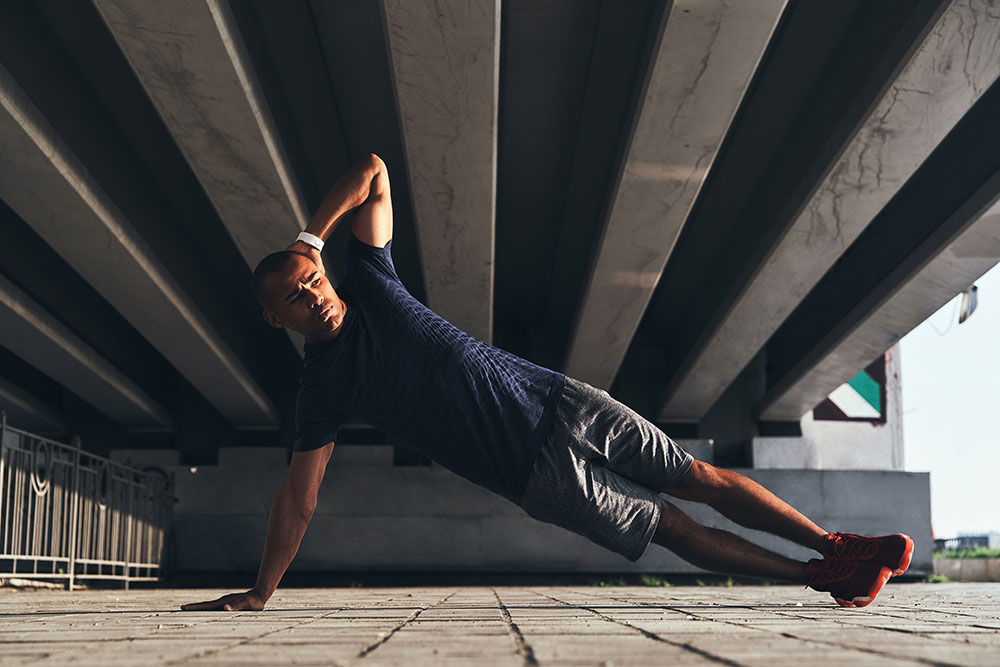
Planks and bridges for core stability
Planks are one of the best all-around exercises for developing core strength. When done correctly, a plank activates not just the abs, but also the deep stabilizing muscles around the spine and pelvis. This helps your body maintain a neutral position during everyday activities, from standing and walking to sitting and bending. Start with a basic forearm plank, making sure your body forms a straight line from head to heels. Engage your core, avoid letting your hips sag, and keep your shoulders pulled back and down. Even holding a plank for 20 to 30 seconds at a time can begin to build the endurance needed for better posture.
Bridges are another effective core-stabilizing exercise that especially targets the glutes and lower back muscles. Lie on your back with knees bent and feet flat on the ground, then lift your hips until your body forms a straight line from shoulders to knees. This move helps counteract the effects of prolonged sitting, which often weakens the glutes and tightens the hips. Strong glutes and lower back muscles support the pelvis and lower spine, making it easier to stand upright with proper alignment. Incorporating bridges and planks regularly helps build the foundational strength that holds your posture in place.
Back extensions to support the spine
Back extensions are essential for building strength in the muscles that run along your spine; particularly the erector spinae. These muscles play a major role in keeping your upper body lifted and your spine straight, especially during prolonged periods of sitting or standing. To perform a simple back extension, lie on your stomach with hands placed lightly behind your head or resting beside your body. Slowly lift your chest off the floor while keeping your neck in line with your spine, then lower back down with control. This movement strengthens the mid-to-lower back and teaches your body how to engage these muscles throughout the day.
Consistent back extension exercises can help reduce slouching and improve your ability to maintain an upright posture without strain. They’re especially helpful for people who tend to round their upper back or lean forward, which can result from desk jobs or phone use. To make the most of this exercise, focus on slow, controlled movements and avoid overextending your lower back. Just a few repetitions each day can create noticeable improvements in posture, balance, and back strength, supporting the natural curves of the spine and relieving unnecessary pressure on surrounding joints.
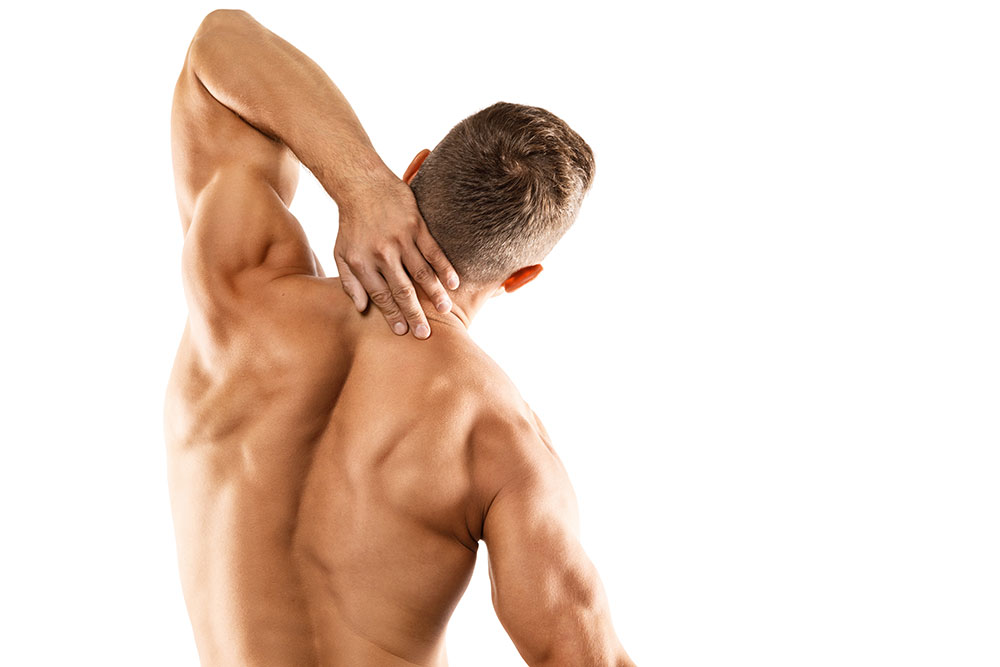
Shoulder blade squeezes for upper back strength
Shoulder blade squeezes are a simple but effective exercise that directly targets the muscles between your shoulder blades, such as the rhomboids and middle trapezius. These muscles are often overlooked, yet they play a big part in keeping your shoulders pulled back and your upper body aligned. To do a shoulder blade squeeze, sit or stand up tall and pull your shoulder blades together as if you’re trying to pinch something between them. Hold for a few seconds, then release. This movement strengthens the upper back and improves your posture by retraining your shoulders to sit in the right position.
This exercise is especially useful for correcting rounded shoulders, which are a common postural issue caused by long hours of hunching forward. By regularly activating the muscles of the upper back, shoulder blade squeezes help counterbalance the forward pull of tight chest muscles. They’re easy to fit into any routine and can even be done discreetly during breaks at work or while sitting on public transport. Over time, this simple motion helps create muscle memory that encourages your body to naturally hold itself in a more open and confident posture.
Stretching for Flexibility
While strengthening exercises help hold your posture in place, stretching is equally important for creating the space and mobility your body needs to stay properly aligned. Tight muscles; especially in the chest, shoulders, hips, and legs can pull your body out of alignment without you even realizing it. Regular stretching helps release this tension, improves range of motion, and allows your muscles to move more freely and naturally. By loosening areas that are commonly overworked or shortened from sitting, stress, or repetitive movements, stretching promotes better balance and posture. In this section, we’ll focus on two key areas that are especially prone to tightness: the chest and shoulders, and the hamstrings and hip flexors. These stretches are gentle yet powerful tools for helping your body maintain a healthy, upright posture throughout the day.
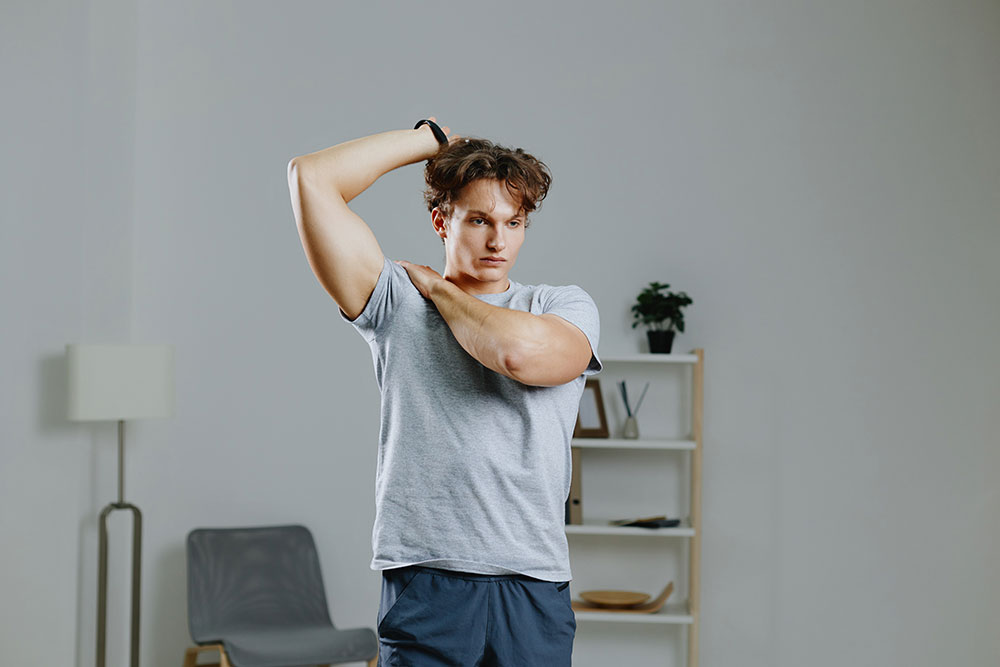
Chest and shoulder stretches to release tension
Tight chest and shoulder muscles are one of the main causes of poor posture, especially the rounded shoulder look that comes from hunching over desks and devices. Stretching these areas regularly helps open up the front of the body and encourages a more lifted, confident stance. One effective stretch is the doorway stretch; simply place your arms on either side of a doorway with elbows bent at 90 degrees and step forward gently until you feel a stretch across your chest. Hold for 20–30 seconds while keeping your spine tall and your neck relaxed. This helps lengthen the pectoral muscles and encourages the shoulders to fall back into their natural position.
Shoulder stretches can also make a big difference, especially when tension builds up from stress or carrying heavy bags. Try the cross-body shoulder stretch, where you pull one arm across your chest and gently hold it with the opposite hand. This targets the rear deltoids and upper back, helping release tightness and restore mobility. Over time, consistent stretching can improve how your shoulders sit, prevent shoulder rolls, and make it easier to maintain an open, elegant posture. These simple movements don’t take long to do but can go a long way in relieving tightness and improving how you carry yourself.
Hamstring and hip flexor stretches for lower body alignment
Tight hamstrings and hip flexors can seriously affect the way your pelvis and lower back align, which in turn impacts your overall posture. When hamstrings are tight, they can pull the pelvis backward and cause the lower back to flatten, leading to poor spinal support. A basic standing or seated hamstring stretch where you gently reach toward your toes while keeping your back flat can help increase flexibility and relieve tension in the backs of your legs. It’s important to go slow and focus on feeling the stretch in the muscle rather than trying to force the movement.
On the other hand, hip flexors often become tight from too much sitting, which pulls the pelvis forward and creates an exaggerated arch in the lower back. To release these muscles, try a kneeling hip flexor stretch: kneel on one leg with the other foot in front and gently push your hips forward while keeping your chest lifted. This helps lengthen the front of the hip and restore balance between the front and back of the body. When your hamstrings and hip flexors are flexible, your pelvis can sit in a more neutral position, supporting the spine and promoting better posture from the ground up. Stretching these areas regularly is a small step that creates a big impact on how you stand and move throughout your day.

Yoga and Pilates for Posture– Building strength and awareness
When it comes to improving posture in a balanced, sustainable way, yoga and Pilates are two of the best methods you can incorporate into your routine. Both practices go beyond basic stretching or strengthening; they teach you how to move mindfully, stay connected to your body, and build deep, lasting support from the inside out. What sets them apart from other forms of exercise is their focus on alignment and control, which is key when trying to improve the way you sit, stand, and walk. These practices can help correct imbalances, increase flexibility, and engage the postural muscles that often get overlooked in everyday movement. While they share some similarities, yoga and Pilates have different strengths that make each uniquely beneficial. In the following sections, we’ll explore how yoga builds awareness and flexibility, while Pilates develops core strength and control; both essential components of healthy, elegant posture.
Yoga for Posture- Flexibility and Body Awareness
Yoga is a powerful tool for improving posture because it encourages full-body awareness and helps release the tension that causes misalignment. Through a mix of standing, seated, and balancing poses, yoga teaches you how to lengthen the spine, open the chest, and ground your body evenly. Poses like Mountain Pose help you understand what it means to stand tall, while Downward Dog gently stretches the back, shoulders, and hamstrings. By focusing on slow, controlled breathing during each movement, yoga also helps calm the nervous system, which reduces stress-related tightness and encourages a more relaxed, natural posture.
One of the greatest benefits of yoga is how it connects your mind and body. As you move through poses, you’re constantly checking in; asking yourself where your weight is, how your shoulders feel, or if your neck is relaxed. Over time, this awareness carries into everyday life, and you start noticing small but important habits like slouching while on your phone or locking your knees when you stand. Regular practice makes it easier to self-correct and maintain better posture without even thinking about it. Whether you’re new to yoga or returning after a break, even simple, beginner-friendly routines can help you develop more graceful, aligned movement.
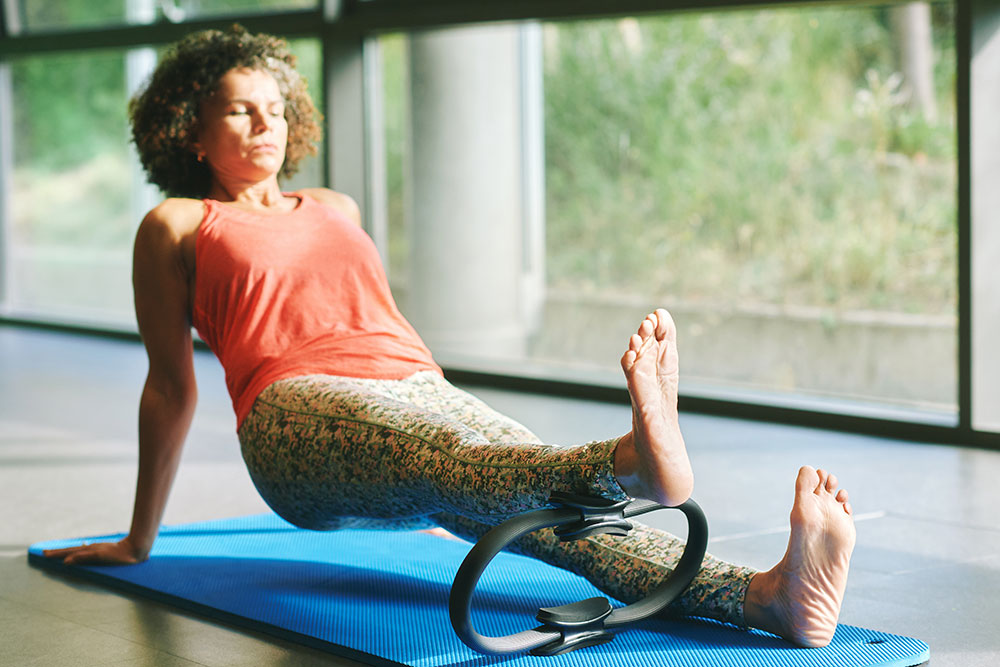
Pilates for Posture- Core Strength and Control
Pilates is especially effective for posture because it targets the deep stabilizing muscles that support your spine and pelvis. Unlike some workouts that focus only on large muscle groups, Pilates activates the core from all angles; front, sides, and back which helps you stay upright and balanced throughout your daily activities. Exercises like the Pilates hundred, leg lifts, and the roll-up not only strengthen the abdominal muscles but also improve your coordination and control. This internal support system is what allows your spine to remain in a healthy position, whether you’re sitting at a desk or walking down the street.
Another strength of Pilates is its structured approach to movement. Every exercise in a Pilates routine is performed with precision, which helps build muscle memory for proper alignment. You’re encouraged to move slowly and with intention, focusing on posture, breathing, and engagement with each rep. This creates a strong foundation that reduces the chances of falling back into old habits like slouching or arching the back too much. Over time, you’ll notice your core becoming stronger, your movements becoming smoother, and your posture feeling more natural and supported. Whether done on a mat or using equipment like the reformer, Pilates is a practical and empowering way to build the strength needed for elegant posture.
Posture-Correction Tools- Ergonomic chairs, lumbar supports, and posture trainers
Even with the best exercises and awareness, daily life often pulls us into habits that work against good posture; especially when we spend hours sitting or using digital devices. That’s where posture-correction tools come in. These products are designed to support your body’s natural alignment, helping you stay comfortable and upright throughout your day. Whether you’re working at a desk, commuting, or relaxing at home, these tools can make a noticeable difference by reducing strain and encouraging better habits. They’re not a substitute for exercise or movement, but they do serve as a great addition to your posture-improvement routine. From well-designed chairs to wearable trainers, these small adjustments in your environment can make a big impact. In this section, we’ll explore three common tools which are ergonomic chairs, lumbar supports, and posture trainers and how they each contribute to a healthier, more elegant posture.

Ergonomic chairs
Ergonomic chairs are specially designed to support your body’s natural posture while sitting, especially during long hours at a desk or workspace. Unlike standard chairs, they promote a neutral spine position by offering adjustable features like seat height, lumbar support, armrests, and seat depth. This customization allows you to sit in a way that keeps your back aligned, your feet flat on the floor, and your shoulders relaxed. A good ergonomic chair will also support the natural curve of your lower back, preventing the common tendency to slouch or lean forward as the day goes on.
Investing in an ergonomic chair is a simple but powerful way to improve your daily posture, especially if you’re working or studying for extended periods. These chairs help reduce tension in the neck and shoulders, minimize pressure on the hips, and support proper circulation in your legs. Over time, they can prevent or relieve back pain caused by poor sitting habits. When used alongside regular movement breaks and core-strengthening exercises, an ergonomic chair creates a supportive foundation that makes it much easier to sit tall and comfortably throughout the day.
Lumbar supports
Lumbar supports are small, portable tools designed to maintain the natural inward curve of your lower spine, known as the lumbar curve. When this curve collapses due to slouching or improper seating, it can lead to back pain, fatigue, and even posture-related injuries. Lumbar cushions or support rolls can be placed on any chair; whether it’s your office chair, car seat, or even a sofa to help maintain healthy spinal alignment. By filling the gap between your lower back and the seat, they provide gentle yet effective support that encourages you to sit upright.
What makes lumbar supports so useful is their flexibility and ease of use. You don’t need to buy new furniture or change your setup entirely; they can be added to almost any seat you already use. They’re especially helpful if you find yourself slouching or rounding your lower back during the day. For best results, make sure the support is positioned at the small of your back while keeping your feet flat and knees at a 90-degree angle. Whether you’re dealing with existing back pain or just want to prevent bad posture, lumbar support can offer everyday comfort and a big improvement in how you carry yourself while seated.
Posture trainers
Posture trainers are wearable devices that help you stay aware of your body alignment throughout the day. Some are physical braces that gently pull your shoulders back and remind you to sit or stand taller. Others are smart tech gadgets that vibrate or send alerts when you begin to slouch. The goal isn’t to force your body into position, but to train your muscles and mind to recognize when you’re falling into poor posture habits. Over time, using a posture trainer can help rewire your posture behavior, making upright alignment feel more natural and effortless.
These tools are especially helpful for people who are just starting their posture journey and need a little extra guidance. While they shouldn’t be worn all day long so your muscles still learn to do the work; they can be a great way to build awareness and consistency. You might wear one during work hours, while doing chores, or when using your phone to keep from slipping into old habits. When combined with stretching, strengthening, and ergonomic support, posture trainers become a smart part of a well-rounded approach to moving and sitting with elegance and ease.
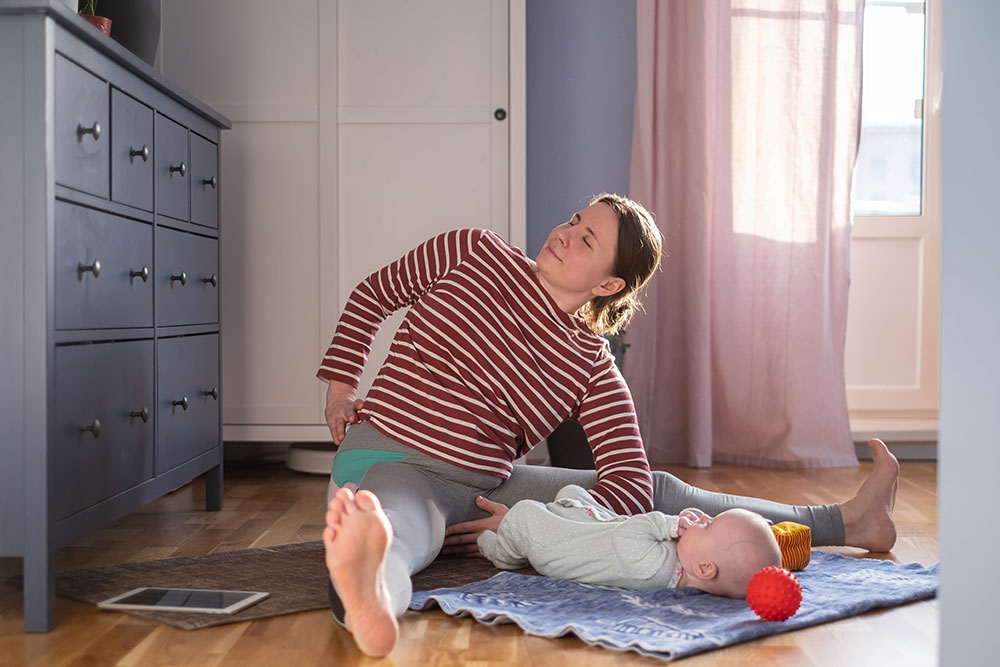
4- Developing Awareness and Postural Habits in Daily Life
Good posture isn’t just about exercise or the occasional stretch but it’s a lifestyle habit that shows up in everything you do, from how you sit at your desk to how you sleep at night. Even with a strong core and flexible body, poor habits in everyday routines can quietly undo your progress. That’s why developing postural awareness throughout the day is so important. It’s about paying attention to how your body moves and rests in different settings and learning to make small adjustments that add up over time. Whether you’re sitting in class, standing in line, scrolling on your phone, or lying in bed, the way you hold yourself matters. These daily moments give you constant opportunities to reinforce healthy posture and prevent discomfort or long-term strain. In this section, we’ll explore four everyday areas where posture plays a key role: sitting, standing, using devices, and sleeping. Each one affects your alignment in a different way, and learning how to support your body properly in these scenarios will help you feel better, move more freely, and carry yourself with lasting ease and confidence.
Sitting Posture– Aligning the back and keeping feet flat on the ground
Sitting might seem like a passive activity, but the way you sit can have a huge impact on your posture, especially if you’re at a desk or in a classroom for most of the day. The key to a healthy sitting posture is maintaining a neutral spine; this means your lower back should retain its natural curve rather than rounding or arching too much. To achieve this, your back should rest against the backrest of your chair, your shoulders should be relaxed but not slouched forward, and your head should be aligned with your spine; not jutting forward. Your knees should be at a 90-degree angle, level with your hips or slightly lower, and your feet should be flat on the floor. If your chair is too high, consider using a footrest to support your feet. This setup takes pressure off your lower back and encourages your body to stay upright without feeling tense or stiff.
Developing good sitting posture isn’t just about how you position yourself at one moment but it’s about building a habit you can maintain throughout the day. Take breaks to stand or stretch every 30 to 60 minutes, especially if you’re working at a computer. You can also adjust your screen height so it’s at eye level, which will stop you from leaning forward or tilting your head down. If you’re sitting on a soft couch or bed, consider adding a small pillow behind your lower back for support. Over time, proper sitting posture reduces the risk of lower back pain, improves circulation, and makes your body feel more comfortable and energized; even after long periods of sitting.
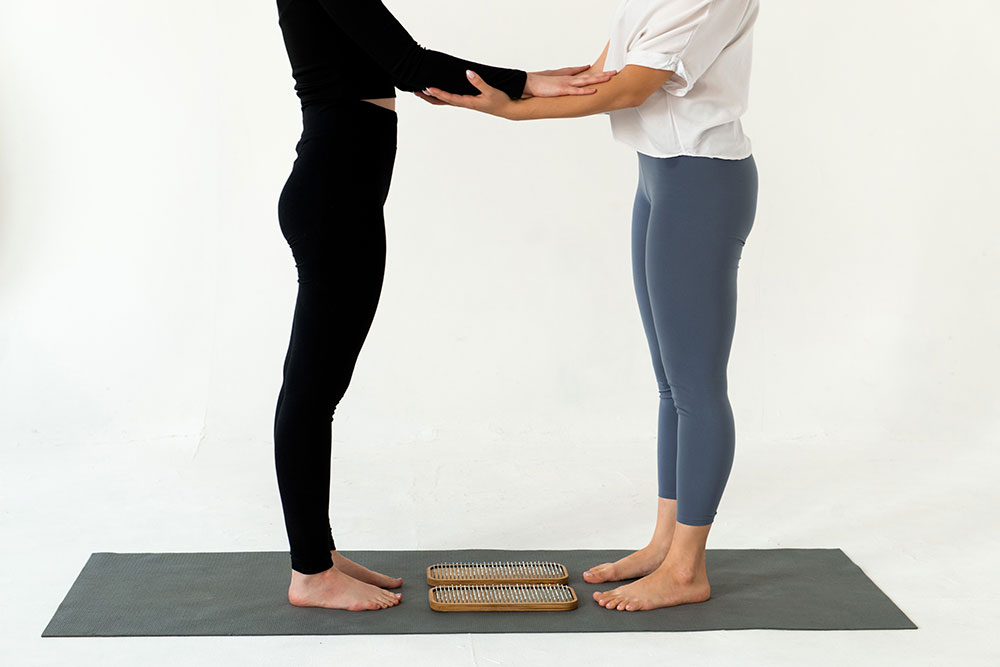
Standing Posture– Distributing weight evenly on both feet
Standing tall doesn’t mean stiff or forced; it means finding a natural, balanced position where your body feels supported and aligned. The foundation of good standing posture starts with your feet. Make sure they are about hip-width apart, and distribute your body weight evenly across both feet, not leaning to one side or shifting into your hips. Your knees should be soft, not locked, and your pelvis should be in a neutral position; not tilted too far forward or backward. Keep your chest lifted, shoulders relaxed and slightly back, and your head aligned with your spine, not pushed forward. When everything is stacked properly, your spine supports your body effortlessly, and you feel more centered and grounded.
Many people unknowingly develop bad habits while standing, like placing all their weight on one leg, slouching their shoulders, or pushing their head forward. These small habits, repeated daily, can lead to muscle imbalances and joint strain. Practicing good standing posture can prevent these issues and also project a sense of calm confidence to those around you. Whether you’re waiting for a train, standing in a queue, or presenting in front of a group, checking in with your alignment makes a difference. Try standing in front of a mirror to observe your posture and notice how it feels when everything is aligned properly. Over time, you’ll train your body to recognize and return to that balanced state naturally.
Posture While Using Devices– Avoiding “tech neck” and slouching over screens
In today’s digital world, we spend a huge portion of our day looking at screens; phones, tablets, laptops, you name it. Unfortunately, this often leads to a posture issue commonly known as “tech neck,” which happens when your head tilts forward and down for long periods. This position puts a lot of strain on the neck and upper back and can lead to stiffness, tension, and long-term alignment issues. To avoid this, aim to keep your screen at eye level whenever possible. For phones or tablets, that might mean holding them higher rather than looking down. When working at a laptop or computer, elevate the screen using a stand or books, and adjust your chair so your eyes naturally meet the top third of the screen.
Besides screen height, the way you hold your shoulders and arms matters too. Keep your shoulders relaxed and avoid hunching them toward your ears. Elbows should be close to your body and form an angle around 90 degrees while typing or scrolling. Taking short breaks every 20–30 minutes to stretch your neck and shoulders can also help. Try standing up and rolling your shoulders or gently tilting your head from side to side to release any built-up tension. Practicing these small adjustments every day reduces digital-related posture problems and helps you stay comfortable and elegant even while navigating modern life.

Posture While Sleeping– Choosing the right pillow and mattress for alignment
Good posture isn’t just a daytime thing but your sleeping position also plays a big role in keeping your spine aligned and your body feeling refreshed. When you lie down, your spine should stay in a neutral position, just like when you’re standing or sitting with good posture. The type of mattress and pillow you use can either support or disrupt that alignment. A mattress that’s too soft may let your body sink in too deeply, throwing off your posture, while one that’s too firm might not support your natural curves. Ideally, your mattress should be medium-firm, offering support without being overly rigid. Your pillow should also suit your sleeping style; side sleepers usually need a thicker pillow to fill the space between the ear and shoulder, while back sleepers do better with a thinner pillow that supports the neck without pushing the head too far forward.
Beyond bedding, your sleep position itself matters. Try to avoid sleeping on your stomach, as it forces your neck into an awkward angle and flattens the natural curve of your spine. Sleeping on your back with a pillow under your knees or on your side with a pillow between your legs can help maintain proper spinal alignment. If you find yourself waking up with neck pain or back discomfort, it might be a sign that your sleep posture needs adjusting. Even though you’re not conscious while sleeping, your body still responds to the way it’s positioned for hours at a time. Taking care of your posture while you sleep helps your muscles recover overnight and sets you up to feel more balanced and aligned the next day.

5- How to Walk Elegantly- The Basics
Walking may seem like the most natural thing in the world, but turning it into an elegant, graceful movement takes awareness, practice, and intention. Elegant walking isn’t about exaggeration or show but it’s about subtle control, fluidity, and posture that reflects confidence and poise. Whether you’re stepping into a room or simply walking down the street, the way you move leaves an impression. This section explores the foundational elements that make a walk look polished and composed. From aligning your spine properly to engaging your core, keeping your shoulders relaxed, and holding your gaze forward, each small adjustment helps build a walk that feels effortless and looks refined. Think of it as the walking version of good posture where grace meets strength in motion.
Aligning Your Posture While Walking– Maintaining a neutral spine
When it comes to walking elegantly, the foundation starts with your posture. Just like in standing or sitting, maintaining a neutral spine while walking is key to moving with grace. A neutral spine refers to the natural curves your spine makes in its proper alignment. When you’re walking, make sure your head is aligned with your neck and the rest of your spine, creating a straight line from the top of your head to your tailbone. Avoid letting your back arch too much or slouching forward, as both positions disrupt your natural spinal alignment and can lead to discomfort or fatigue. Keeping a neutral spine prevents strain on your back and neck, allowing you to move smoothly and with less effort.
One important aspect of maintaining this alignment while walking is ensuring your pelvis stays in a neutral position. Don’t let it tip forward or backward too much; this can happen naturally if you arch your lower back or tuck your hips in too far. The pelvis should be aligned with the rest of your body to avoid extra pressure on your lower spine. As you walk, imagine a string gently pulling you up from the top of your head, keeping your torso tall and centered. This visual will help you avoid leaning forward, which is a common posture mistake while walking, especially when walking at a faster pace or when distracted.
Proper spinal alignment while walking also encourages a natural, fluid movement of the arms and legs. When you maintain an upright and aligned posture, your limbs can swing more naturally, which helps create a smoother, more effortless stride. On the contrary, poor posture; like slouching or leaning forward can restrict the swing of your arms and cause you to take shorter, more rigid steps. This disrupts the elegance of your walk and can lead to more stiffness in the body. By keeping your spine neutral and balanced, you enable your entire body to move in harmony, which contributes to a more elegant, graceful gait.

Engaging Your Core- Supporting movement with abdominal muscles
Engaging your core is one of the most effective ways to improve your posture and walking technique. The core includes not only your abdominal muscles but also the muscles in your back, pelvis, and diaphragm. These muscles work together to stabilize and support your spine, helping you maintain balance and control as you walk. When your core is engaged, it prevents your upper body from swaying too much or losing alignment, ensuring that your walk remains smooth and coordinated. It’s like the foundation of a building; without it, everything else lacks stability. To engage your core, gently draw your belly button towards your spine and tighten your lower abdominal muscles. This creates a subtle but effective support system for your entire body as you walk.
Walking with an engaged core also improves your overall posture, especially in your lower back. When the abdominal muscles are activated, they help take some of the strain off your spine, reducing the risk of lower back pain or discomfort that can arise from poor posture. If your core isn’t engaged, your spine may start to slump or tilt in unnatural ways, causing your walk to become unbalanced. By focusing on keeping your core muscles engaged, you’ll help your body stay upright and strong, without feeling overly stiff. It’s important, though, not to overdo it while you should keep your core engaged, avoid holding your breath or tightening up so much that it restricts your movement.
Beyond providing support, an engaged core contributes to the fluidity of your movement. It helps control the swinging motion of your legs and prevents excessive movement in your torso. This allows your walk to remain steady and elegant, rather than jerky or uneven. With a strong core, each step you take will feel more controlled, helping you glide rather than stumble. Additionally, engaging your core can improve your balance, especially if you’re walking on uneven surfaces or at a quicker pace. It provides a sturdy base of support, so you can move confidently and with greater ease, even in more challenging environments.

Relaxing the Shoulders-Avoiding tension while maintaining an open posture
One of the most important yet often overlooked elements of walking elegantly is relaxing the shoulders. Tension in the shoulders not only affects your posture but also makes your walk appear stiff and forced. When your shoulders are tense or hunched up, it creates a tight, uncomfortable feeling throughout your upper body, which can hinder fluid movement. To achieve a more graceful walk, consciously drop your shoulders away from your ears. Imagine there’s a weight pulling your shoulders gently down and back, creating a sense of ease across your chest and upper back. This relaxed posture will help you maintain an open, confident stance as you move.
Relaxing your shoulders also plays a crucial role in ensuring your arms swing naturally. When your shoulders are tense, your arms are less likely to move freely, which can make your walk look rigid or awkward. Allow your arms to swing gently in rhythm with your stride; this will help maintain fluidity and balance. The natural swing of the arms complements the movement of the legs, so if the shoulders are relaxed, your whole body will move more effortlessly. Additionally, a relaxed shoulder posture prevents the chest from collapsing inward, which can cause you to look hunched and less confident. Keeping your shoulders open and relaxed keeps your posture upright and aligned, making your entire walk appear more poised.
Another benefit of relaxing the shoulders is that it helps with breathing. When your shoulders are tense, it can restrict the movement of your diaphragm and limit your ability to take full, deep breaths. This can result in shallow breathing, which makes you appear nervous or stiff. By consciously relaxing your shoulders, you open up the chest, making it easier to breathe deeply and steadily. As a result, you’ll not only look more at ease while walking, but you’ll feel more calm and composed. This relaxed, open posture creates an air of confidence and elegance, allowing you to move with grace and maintain a natural, comfortable stride.

Looking Ahead– Keeping your head level and eyes forward
Keeping your head level and eyes forward is one of the simplest yet most powerful adjustments you can make to walk with elegance. When you walk with your head tilted forward or looking down, it not only affects your posture but also gives off a sense of uncertainty or lack of confidence. To walk with poise, your head should be aligned with your spine, and your gaze should be directed straight ahead, not downward. Imagine there’s a line from the top of your head extending straight to the horizon. This alignment encourages a straight back and shoulders, helping you maintain an open and confident posture. Looking forward also helps you navigate your surroundings more efficiently, without appearing distracted or unsure.
When your head is properly aligned with your body, it promotes balance and stability. Looking straight ahead prevents unnecessary strain on your neck, which can occur when you look down for extended periods. This position allows your spine to maintain its natural curves, preventing you from slouching or tilting your body in awkward ways. Furthermore, keeping your eyes forward enhances your spatial awareness, helping you avoid obstacles or distractions while maintaining a smooth, controlled walk. This is especially important when navigating busy environments, such as crowded streets or events, where an alert and composed demeanor is key to looking elegant.
Finally, looking ahead with confidence also influences how others perceive you. It projects a sense of self-assurance, composure, and purpose. People naturally associate forward-looking individuals with confidence, and it can even make you appear taller and more approachable. By maintaining this simple habit of keeping your head level and eyes forward, you’ll instantly enhance the elegance of your walk, conveying both poise and confidence. Not only will you appear more graceful, but you’ll also feel more in control and centered in your movements.
Continue Reading
- How to have a good posture and walk elegantly / Part 1
- How to have a good posture and walk elegantly / Part 2
- How to have a good posture and walk elegantly / Part 3
- How to have a good posture and walk elegantly / Part 4
- How to have a good posture and walk elegantly / Part 5
Written By: Muskaan Khojestagan



Add a Comment